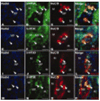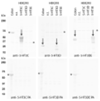Serotonin receptor diversity in the human colon: Expression of serotonin type 3 receptor subunits 5-HT3C, 5-HT3D, and 5-HT3E
- PMID: 21192076
- PMCID: PMC3056486
- DOI: 10.1002/cne.22525
Serotonin receptor diversity in the human colon: Expression of serotonin type 3 receptor subunits 5-HT3C, 5-HT3D, and 5-HT3E
Abstract
Since the first description of 5-HT₃ receptors more than 50 years ago, there has been speculation about the molecular basis of their receptor heterogeneity. We have cloned the genes encoding novel 5-HT3 subunits 5-HT3C, 5-HT3D, and 5-HT3E and have shown that these subunits are able to form functional heteromeric receptors when coexpressed with the 5-HT3A subunit. However, whether these subunits are actually expressed in human tissue remained to be confirmed. In the current study, we performed immunocytochemistry to locate the 5-HT3A as well as the 5-HT3C, 5-HT3D, and 5-HT3E subunits within the human colon. Western blot analysis was used to confirm subunit expression, and RT-PCR was employed to detect transcripts encoding 5-HT₃ receptor subunits in microdissected tissue samples. This investigation revealed, for the first time, that 5-HT3C, 5-HT3D, and 5-HT3E subunits are coexpressed with 5-HT3A in cell bodies of myenteric neurons. Furthermore, 5-HT3A and 5-HT3D were found to be expressed in submucosal plexus of the human large intestine. These data provide a strong basis for future studies of the roles that specific 5-HT₃ receptor subtypes play in the function of the enteric and central nervous systems and the contribution that specific 5-HT₃ receptors make to the pathophysiology of gastrointestinal disorders such as irritable bowel syndrome and dyspepsia.
© 2010 Wiley-Liss, Inc.
Figures






Similar articles
-
Characterization of the novel human serotonin receptor subunits 5-HT3C,5-HT3D, and 5-HT3E.Mol Pharmacol. 2007 Jul;72(1):8-17. doi: 10.1124/mol.106.032144. Epub 2007 Mar 28. Mol Pharmacol. 2007. PMID: 17392525
-
Characterisation of 5-HT3C, 5-HT3D and 5-HT3E receptor subunits: evolution, distribution and function.J Neurochem. 2009 Jan;108(2):384-96. doi: 10.1111/j.1471-4159.2008.05775.x. Epub 2008 Nov 29. J Neurochem. 2009. PMID: 19012743
-
RIC-3 exclusively enhances the surface expression of human homomeric 5-hydroxytryptamine type 3A (5-HT3A) receptors despite direct interactions with 5-HT3A, -C, -D, and -E subunits.J Biol Chem. 2010 Aug 27;285(35):26956-26965. doi: 10.1074/jbc.M110.122838. Epub 2010 Jun 3. J Biol Chem. 2010. PMID: 20522555 Free PMC article.
-
Advances in the pharmacology of lGICs auxiliary subunits.Pharmacol Res. 2015 Nov;101:65-73. doi: 10.1016/j.phrs.2015.07.026. Epub 2015 Aug 7. Pharmacol Res. 2015. PMID: 26255765 Review.
-
Heterogeneity amongst 5-HT₃ receptor subunits: is this significant?Curr Mol Med. 2011 Feb;11(1):57-68. doi: 10.2174/156652411794474392. Curr Mol Med. 2011. PMID: 21189117 Review.
Cited by
-
Predominant mucosal expression of 5-HT₄(+h) receptor splice variants in pig stomach and colon.World J Gastroenterol. 2013 Jun 28;19(24):3747-60. doi: 10.3748/wjg.v19.i24.3747. World J Gastroenterol. 2013. PMID: 23840113 Free PMC article.
-
Association of genetic polymorphisms in HTR3A and HTR3E with diarrhea predominant irritable bowel syndrome.Int J Clin Exp Med. 2015 Mar 15;8(3):4581-5. eCollection 2015. Int J Clin Exp Med. 2015. PMID: 26064388 Free PMC article.
-
Irritable bowel syndrome: methods, mechanisms, and pathophysiology. Genetic epidemiology and pharmacogenetics in irritable bowel syndrome.Am J Physiol Gastrointest Liver Physiol. 2012 May 15;302(10):G1075-84. doi: 10.1152/ajpgi.00537.2011. Epub 2012 Mar 8. Am J Physiol Gastrointest Liver Physiol. 2012. PMID: 22403795 Free PMC article. Review.
-
5-HT(3) receptors.J Biol Chem. 2012 Nov 23;287(48):40239-45. doi: 10.1074/jbc.R112.406496. Epub 2012 Oct 4. J Biol Chem. 2012. PMID: 23038271 Free PMC article. Review.
-
Structure, Function and Physiology of 5-Hydroxytryptamine Receptors Subtype 3.Subcell Biochem. 2021;96:373-408. doi: 10.1007/978-3-030-58971-4_11. Subcell Biochem. 2021. PMID: 33252737 Review.
References
-
- Bearcroft CP, Andre EA, Farthing MJ. In vivo effects of the 5-HT3 antagonist alosetron on basal and cholera toxin-induced secretion in the human jejunum: a segmental perfusion study. Aliment Pharmacol Ther. 1997;11:1109–1114. - PubMed
-
- Belelli D, Balcarek JM, Hope AG, Peters JA, Lambert JJ, Blackburn TP. Cloning and functional expression of a human 5-hydroxytryptamine type 3AS receptor subunit. Mol Pharmacol. 1995;48:1054–1062. - PubMed
-
- Bertrand PP, Kunze WAA, Bornstein JC, Furness JB, Smith ML. Analysis of the responses of myenteric neurons in the small intestine to chemical stimulation of the mucosa. Am J Physiol. 1997;36:G422–G435. - PubMed
-
- Bottner M, Bar F, Von Koschitzky H, Tafazzoli K, Roblick UJ, Bruch HP, Wedel T. Laser microdissection as a new tool to investigate site-specific gene expression in enteric ganglia of the human intestine. Neurogastroenterol Motil. 2009;22:168–172. e152. - PubMed
Publication types
MeSH terms
Substances
Grants and funding
LinkOut - more resources
Full Text Sources
Other Literature Sources
Molecular Biology Databases

